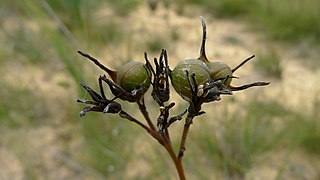
Anacardium, the cashews, are a genus of flowering plants in the family Anacardiaceae, native to tropical regions of the Americas.
Sycamore is a name which has been applied to several types of trees, but with somewhat similar leaf forms. The name derives from the ancient Greek συκόμορος (sūkomoros) meaning "fig-mulberry".
Pyrethrum was a genus of several Old World plants now classified as Chrysanthemum or Tanacetum which are cultivated as ornamentals for their showy flower heads. Pyrethrum continues to be used as a common name for plants formerly included in the genus Pyrethrum. Pyrethrum is also the name of a natural insecticide made from the dried flower heads of Chrysanthemum cinerariifolium and Chrysanthemum coccineum. Its active ingredient are pyrethrins.

Tanacetum is a genus of about 160 species of flowering plants in the aster family, Asteraceae, native to many regions of the Northern Hemisphere. They are known commonly as tansies. The name tansy can refer specifically to Tanacetum vulgare, which may be called the common tansy or garden tansy for clarity.

Tansy is a perennial, herbaceous flowering plant of the aster family, native to temperate Europe and Asia. It has been introduced to other parts of the world, including North America, and in some areas has become invasive. It is also known as common tansy, bitter buttons, cow bitter, or golden buttons. The Latin word vulgare means "common".

Ageratum is a genus of 40 to 60 tropical and warm temperate flowering annuals and perennials from the family Asteraceae, tribe Eupatorieae. Most species are native to Central America and Mexico but four are native to the United States.

Tanacetum parthenium, known as feverfew, is a flowering plant in the daisy family, Asteraceae. It may be grown as an ornament, and is usually identified by its synonyms, Chrysanthemum parthenium and Pyrethrum parthenium.

Vaccinium corymbosum, the northern highbush blueberry, is a North American species of blueberry which has become a food crop of significant economic importance. It is native to eastern Canada and the eastern and southern United States, from Ontario east to Nova Scotia and south as far as Florida and eastern Texas. It is also naturalized in other places: Europe, Japan, New Zealand, the Pacific Northwest of North America, etc. Other common names include blue huckleberry, tall huckleberry, swamp huckleberry, high blueberry, and swamp blueberry.

Sparganothis pilleriana, also known as the vine leafroller tortrix, is a moth of the family Tortricidae found in the Palearctic realm. It was first described by the Austrian lepidopterists Michael Denis and Ignaz Schiffermüller in 1775.

Gillmeria pallidactyla is a moth of the family Pterophoridae first first described by the English entomologist, Adrian Hardy Haworth in 1811. It has a Holarctic distribution and is widespread throughout North America and Eurasia.

Tanacetum cinerariifolium is a species of flowering plant in the aster family, Asteraceae., and formerly part of the genus Pyrethrum, but now placed in the genus Chrysanthemum, or the genus Tanacetum by some biologists. It is called the Dalmatian chrysanthemum, denoting its origin in that region of the Balkans (Dalmatia). It looks more like the common daisy than other pyrethrums do. Its flowers, typically white with yellow centers, grow from numerous fairly rigid stems. Plants have blue-green leaves and grow to 45 to 100 cm in height.
Coleophora chrysanthemi is a moth of the family Coleophoridae. It is found from Finland to Italy and Hungary.

Depressaria olerella is a moth of the family Depressariidae. It is found in most of Europe, except Ireland, the Netherlands, the Iberian Peninsula and most of the Balkan Peninsula.
Cassida denticollis is a species of leaf beetle, situated in the subfamily Cassidinae and the genus Cassida, found in Mongolia, West China, and the Western Palaearctic region.

Teucrium corymbosum, commonly known as forest germander, is a species of flowering plant in the family Lamiaceae and is native to Australia and New Guinea. It is a perennial herb or subshrub densely covered with glands and with narrow egg-shaped leaves usually with toothed edges, and groups of mostly up to ten white flowers.

Aethes kindermanniana is a species of moth of the family Tortricidae. It was described by Treitschke in 1830. It is found on Sardinia and in Denmark, Germany, France, Spain, Italy, Switzerland, Austria, the Czech Republic, Slovakia, Poland, Hungary, Romania, Norway, Sweden, Finland, the Baltic region, Ukraine, Russia. and Asia Minor. It has also been recorded from North America.

Haemodorum corymbosum, commonly known as the rush-leaf bloodroot, is a shrub native to southeastern Australia. Danish-Norwegian naturalist Martin Vahl described this species in his 1805 work Enumeratio Plantarum.
Scrobipalpa chrysanthemella is a moth in the family Gelechiidae. It was described by Ernst Hofmann in 1867. It is found in Germany, Austria, Switzerland, Italy, the Czech Republic, Slovakia, Serbia, Bosnia and Herzegovina, Hungary, Romania, Russia and Turkey.
Scrobipalpa voltinella is a moth in the family Gelechiidae. It was described by Pierre Chrétien in 1898. It is found in Spain, southern France, Italy, Croatia, Serbia, Turkey and Ukraine.

Vaccinium fuscatum, the black highbush blueberry, is a species of flowering plant in the heath family (Ericaceae). It is native to North America, where it is found in Ontario, Canada and the eastern United States. Its typical natural habitat is wet areas such as bogs, pocosins, and swamps.













